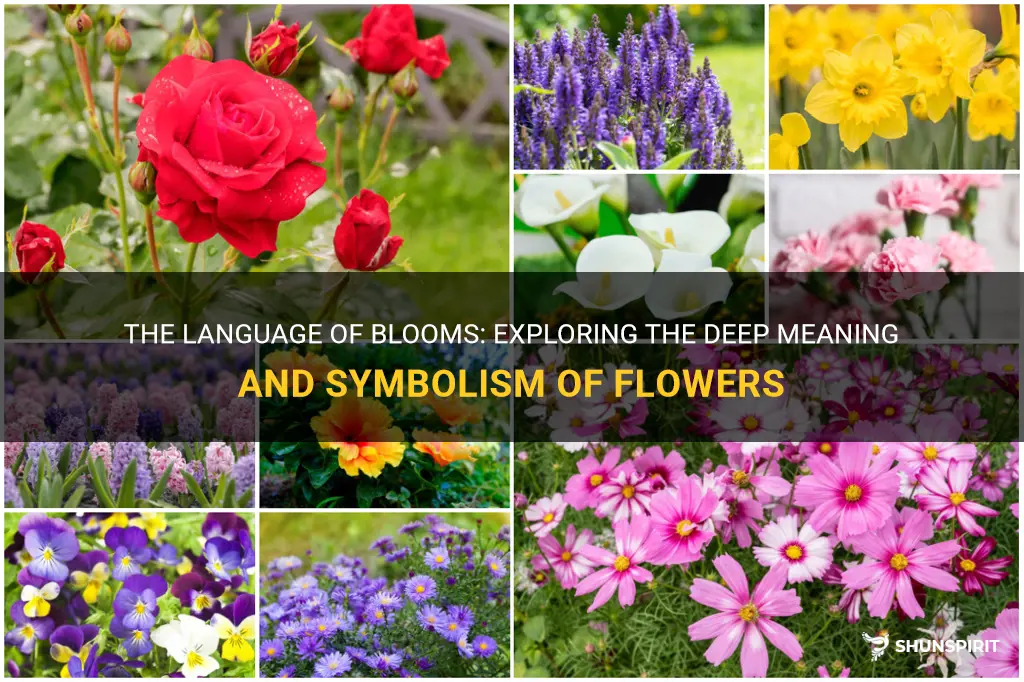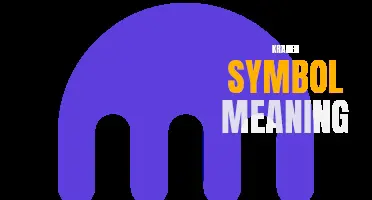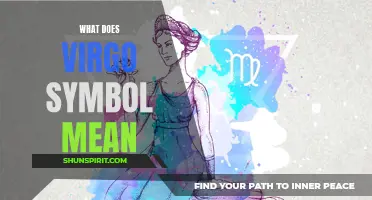
Flowers have held a significant place in human culture throughout history, not just for their beauty and fragrance, but also for the symbolism and meaning they carry. Whether it's a red rose symbolizing love or a white lily representing purity, flowers have the power to convey emotions and messages with their vibrant colors and delicate petals. From ancient civilizations using flowers in rituals and offerings to the language of flowers in Victorian times, the intricate meanings behind different floral varieties have woven their way into our collective consciousness. Join me as we delve into the fascinating world of flower symbolism, exploring how a simple bloom can communicate so much without saying a word.
What You'll Learn
- What is the meaning and symbolism behind specific flowers, such as roses or sunflowers?
- How have the meanings associated with certain flowers evolved throughout history?
- Are there any cultural differences in the meanings and symbolism of flowers?
- How can the meaning and symbolism of flowers be incorporated into various forms of art or literature?
- Can the meaning and symbolism of flowers vary depending on the color or arrangement of the flowers?

What is the meaning and symbolism behind specific flowers, such as roses or sunflowers?
Flowers have been a part of human culture and traditions for centuries. They are not only beautiful and fragrant, but they also carry significant meanings and symbolism. Different flowers have different meanings associated with them, and understanding these meanings can help us express our emotions and intentions through the language of flowers. Here, we will explore the symbolism behind two popular flowers: roses and sunflowers.
Roses are often seen as the ultimate symbol of love and romance. The red rose, in particular, represents passionate love and desire. It has been used for centuries to convey deep affection and has become associated with Valentine's Day and anniversaries. Apart from red roses, different colored roses carry different meanings. For example, pink roses symbolize gratitude and appreciation, while yellow roses represent friendship and joy. White roses, on the other hand, are often associated with purity and innocence, making them a popular choice for weddings and funerals.
Sunflowers, on the other hand, symbolize adoration and loyalty. These vibrant flowers are known for their large, radiant blooms that turn to face the sun. As a result, they have come to represent positivity, strength, and the ability to embrace the sunshine even in difficult times. Sunflowers can also symbolize longevity and good luck. They are often given as gifts to uplift someone's spirits or to express admiration and support. Additionally, the seeds of sunflowers have been used as a symbol of fertility and the cycle of life.
It is important to note that flower symbolism can vary across different cultures and time periods. While certain meanings have become widely accepted, it is always a good idea to consider the specific cultural or personal context when choosing and interpreting the symbolism of flowers.
In addition to their individual meanings, flowers can also be combined to create unique and meaningful arrangements. For example, a bouquet of red and white roses can symbolize unity and everlasting love, while a mix of sunflowers and daisies can represent optimism and new beginnings. The combination of flowers can enhance and deepen the messages we want to convey through the language of flowers.
Flowers have a universal appeal and a language of their own. They offer a way to express emotions and sentiments when words are simply not enough. Whether you are giving or receiving flowers, taking the time to understand their meanings and symbolism adds depth and significance to the gesture. So, the next time you choose a bouquet or admire a flower, take a moment to appreciate the hidden messages and the beauty they represent.
Understanding the Symbols on a Multimeter: A Comprehensive Guide
You may want to see also

How have the meanings associated with certain flowers evolved throughout history?
Flowers have long been associated with different meanings and symbolism throughout history. From ancient civilizations to modern times, the meanings attributed to certain flowers have evolved and changed over time. Today, we will explore how the meanings associated with flowers have transformed throughout history.
In ancient civilizations, flowers played a significant role in religious rituals and cultural practices. For example, in ancient Greece, the lotus flower symbolized purity and rebirth. It was often used in religious ceremonies and depicted in artworks and sculptures. Similarly, in ancient Egypt, the blue lotus flower represented life, fertility, and resurrection. These early associations with flowers laid the foundation for their symbolic meanings in later cultures.
During the Middle Ages in Europe, flowers took on new meanings and were often used as a form of communication. People would exchange flowers as a way to convey messages and emotions that were not acceptable to express openly. This practice, known as "floriography," became particularly popular during the Victorian era, where each flower had specific meanings.
For example, the red rose came to symbolize romantic love and passion, while the white rose represented purity and innocence. The daisy was associated with innocence and simplicity, but also with secrets and hidden love. The tulip, on the other hand, symbolized perfect love. These meanings were often expressed through flower arrangements or by giving a specific flower to someone.
As time passed and societies evolved, some of these meanings have shifted or lost their significance. In modern times, flowers are often given for various occasions, such as birthdays, anniversaries, or as a gesture of sympathy. While some associations, such as the red rose's connection to love, still hold true, other meanings have become less prominent.
Additionally, the rise of commercial flower production and the availability of flowers year-round have also influenced the meanings associated with flowers. Today, people may choose flowers based on their aesthetic appeal rather than their traditional symbolism. For example, a person may give someone their favorite flowers simply because they like how they look or smell, without considering the historical or cultural meanings behind them.
However, it is worth noting that certain flowers still maintain their symbolic significance in different contexts. For instance, the lily is often associated with funerals and symbolizes the soul's return to innocence after death. Similarly, the sunflower is commonly associated with happiness and positivity.
In conclusion, the meanings associated with flowers have evolved throughout history. From ancient civilizations to modern times, flowers have symbolized various emotions, messages, and cultural values. While some traditional meanings are still acknowledged today, others have become less relevant or are no longer widely known. However, flowers continue to hold a special place in our lives as a way to express emotions, celebrate special occasions, and add beauty to our surroundings.
Decoding the Mystical World of Viking Runic Symbols and Their Meanings
You may want to see also

Are there any cultural differences in the meanings and symbolism of flowers?
Flowers have long been used to convey emotions and send messages. From expressing love and gratitude to mourning and sympathy, flowers have a universal language that transcends borders and cultures. However, there are also culturally specific meanings and symbolism attached to certain flowers that vary from country to country. Understanding these cultural differences can help avoid misunderstandings and ensure that the intended message is properly communicated.
In Asia, for example, the meanings of flowers often have intricate associations with specific cultural beliefs and traditions. In Japan, the cherry blossom holds great significance and represents the fleeting nature of life and the beauty in impermanence. Similarly, in China, the symbol of the peony is associated with wealth, prosperity, and honor. On the other hand, white flowers, particularly chrysanthemums, are commonly associated with death and are often used in funerals or as offerings to ancestors.
In European cultures, flowers also carry their own unique meanings and symbolism. For instance, red roses are universally associated with love and romance. In many Western countries, giving someone a bouquet of red roses is a classic declaration of love. However, in some Eastern European countries, such as Russia, yellow roses are seen as a symbol of romantic rejection.
The language of flowers, or floriography, was particularly popular in the Victorian era. Each flower had a specific meaning, allowing people to send secret messages through the arrangement of different blooms. For example, a red carnation symbolized admiration, while a yellow tulip represented unrequited love. This language of flowers was often used in courtship and during social gatherings where open displays of affection were frowned upon.
In some Middle Eastern and African cultures, flowers are often used as symbols of celebration and joy. In Egypt, for instance, the lotus flower is considered sacred and represents rebirth and spiritual enlightenment. Similarly, the hibiscus flower is often used in African rituals and symbolizes beauty and femininity.
It is important to note that while cultural meanings and symbolism of flowers exist, personal preferences and interpretations can still vary. Ultimately, the intention behind giving flowers should be considered, and it is always advisable to research and respect the cultural significance of flowers when giving them as gifts or using them in certain occasions.
In conclusion, flowers have a rich and diverse language that carries different meanings and symbolism across cultures. Understanding these cultural differences can enhance the messages we convey through flowers and help us connect on a deeper level with others. Whether it is expressing love, gratitude, or sorrow, the universal language of flowers continues to bring people together and evoke emotions that transcend cultural boundaries.
The Hidden Meanings and Symbolism of Horseshoes: Unlocking their Powerful Significance
You may want to see also

How can the meaning and symbolism of flowers be incorporated into various forms of art or literature?
Flowers have long been a source of inspiration for artists and writers, with their beauty and symbolism adding depth and meaning to various art forms. From paintings to poems, flowers have been incorporated into art and literature in numerous ways, allowing artists and writers to convey emotions, themes, and messages in a captivating manner.
One way in which flowers are incorporated into art is through their representation in paintings. Artists throughout history have sought to capture the essence of flowers, using their vibrant colors and delicate petals to create visually stunning works of art. Whether it's Vincent van Gogh's sunflowers or Georgia O'Keeffe's large-scale flower paintings, these artists have used flowers to bring life and beauty to their canvases.
In addition to their visual appeal, flowers also carry symbolic meanings that artists and writers can use to convey deeper messages. For example, the rose is often used to represent love and romance, while the lily symbolizes purity and innocence. By incorporating these symbols into their work, artists and writers can evoke specific emotions and create a richer, more layered experience for the audience.
Flowers can also be used to illustrate themes and motifs in literature. Writers often use flowers as metaphors or symbols to explore ideas such as beauty, growth, and mortality. For instance, in William Shakespeare's play Romeo and Juliet, the character Friar Laurence uses flowers to symbolize the transient nature of life and love, stating, "So shows a snowy dove trooping with crows / As yonder lady o'er her fellows shows. / The measure done, I'll watch her place of stand, / And, touching hers, make blessèd my rude hand. / Did my heart love till now? Forswear it, sight! / For I ne'er saw true beauty till this night." Here, the contrast between the pure, white dove and the dark, common crows highlights the beauty and rarity of Juliet in the eyes of Romeo.
Furthermore, flowers can also be used to establish a sense of time and place in literature. For example, authors often use specific flowers to evoke a particular season or geographical location. The delicate cherry blossoms of Japan, for instance, are often used to create an atmosphere of springtime and renewal, while the fiery red poppies of Flanders Fields evoke images of war and sacrifice.
Overall, the meaning and symbolism of flowers can be skillfully incorporated into various forms of art and literature. Artists and writers can draw upon the beauty and symbolic significance of flowers to create visually striking works or to convey deeper messages and themes. By using flowers as a powerful tool, these creative individuals can captivate audiences and create a lasting impact through their art and writing.
Decoding the Dark: Unraveling the Meaning Behind Bad Omens Band Symbols
You may want to see also

Can the meaning and symbolism of flowers vary depending on the color or arrangement of the flowers?
Flowers have held symbolic meanings for centuries and are often given as gifts to express emotions and convey messages. The color and arrangement of flowers can significantly affect their symbolic meanings and the messages they convey.
The color of flowers is closely tied to their symbolism. For example, red roses symbolize love and romance, while white roses represent purity and innocence. Yellow flowers are often associated with friendship and can be a symbol of joy, while purple flowers are typically associated with luxury and royalty. The meanings attached to specific colors can vary across different cultures, so it’s important to consider cultural interpretations as well.
In addition to color, the arrangement of flowers can also impact their symbolism. The way flowers are arranged can alter the overall message being sent. For example, a single rose in a bouquet typically represents love and admiration, while a dozen roses can symbolize a strong romantic bond. Similarly, flowers presented in a formal arrangement may convey a sense of elegance, while a casual or loose arrangement can express a more carefree and relaxed sentiment.
It is also worth mentioning that certain flowers hold specific meanings regardless of their color or arrangement. For instance, lilies are often associated with funerals and are considered a symbol of purity and rebirth. Sunflowers, with their bright and vibrant appearance, are often associated with happiness, positivity, and loyalty. The meanings of these flowers are less influenced by their color or arrangement and are more closely tied to their inherent symbolism.
When choosing flowers for a specific occasion or to convey a particular message, it is important to consider both the color and arrangement. By understanding the symbolism attached to different colors and arranging the flowers in a way that aligns with the intended message, you can create a more meaningful and impactful gift. Additionally, considering the preferences and cultural interpretations of the recipient is also crucial to ensure the message conveyed is received and understood correctly.
In conclusion, the meaning and symbolism of flowers can vary depending on the color and arrangement. The color of a flower is closely tied to its symbolic meaning, but cultural interpretations should also be considered. The arrangement of flowers can alter the overall message being conveyed, with different arrangements conveying different emotions and sentiments. By carefully selecting the color and arrangement of flowers, one can express specific messages and emotions with greater clarity.
The Symbolic Meaning of Ivy: Uncovering Its Significance in Nature and Culture
You may want to see also
Frequently asked questions
A red rose is a symbol of love and romance. It is often given as a gift on Valentine's Day or to express feelings of passion and deep affection.
A white lily is a symbol of purity, innocence, and spirituality. It is often associated with religious ceremonies, such as weddings and funerals.
A sunflower is a symbol of happiness, positivity, and loyalty. Its bright yellow petals and tall stem often represent the sun and its life-giving energy.
A daisy is a symbol of innocence, purity, and new beginnings. It is often associated with spring and used in flower crowns or bouquets to represent youthfulness and a fresh start.
A tulip symbolizes perfect love and deep passion. Different colors of tulips can have additional meanings, such as red tulips symbolizing true love, yellow tulips representing cheerfulness, and purple tulips expressing royalty.







